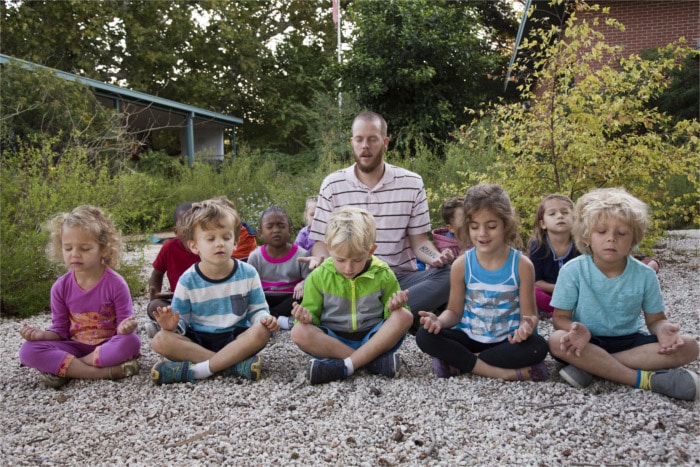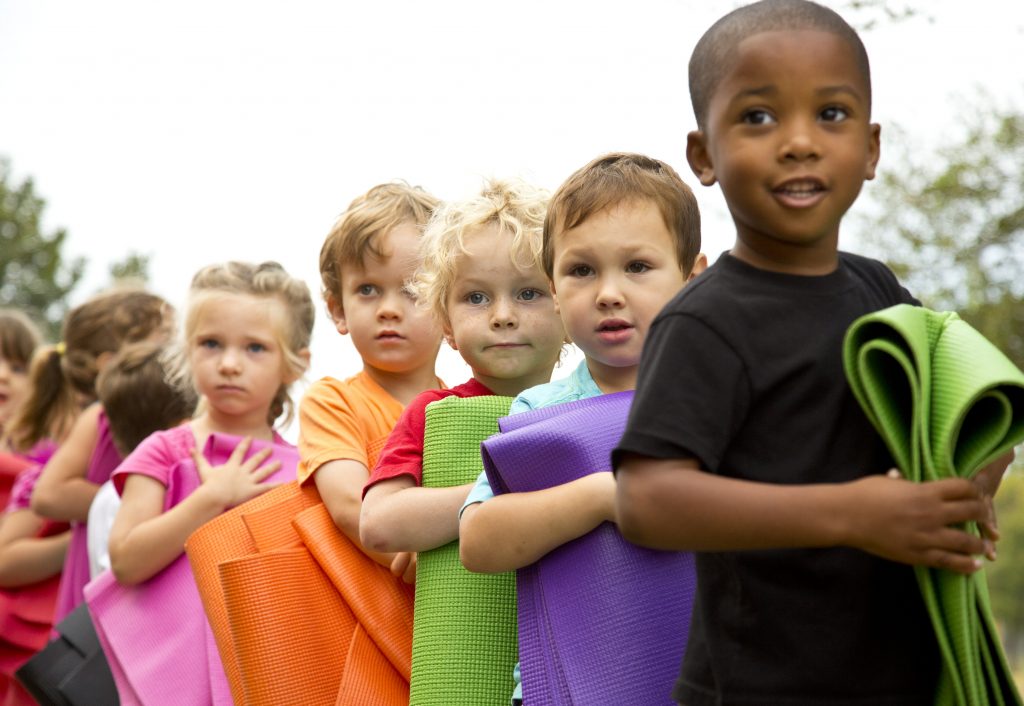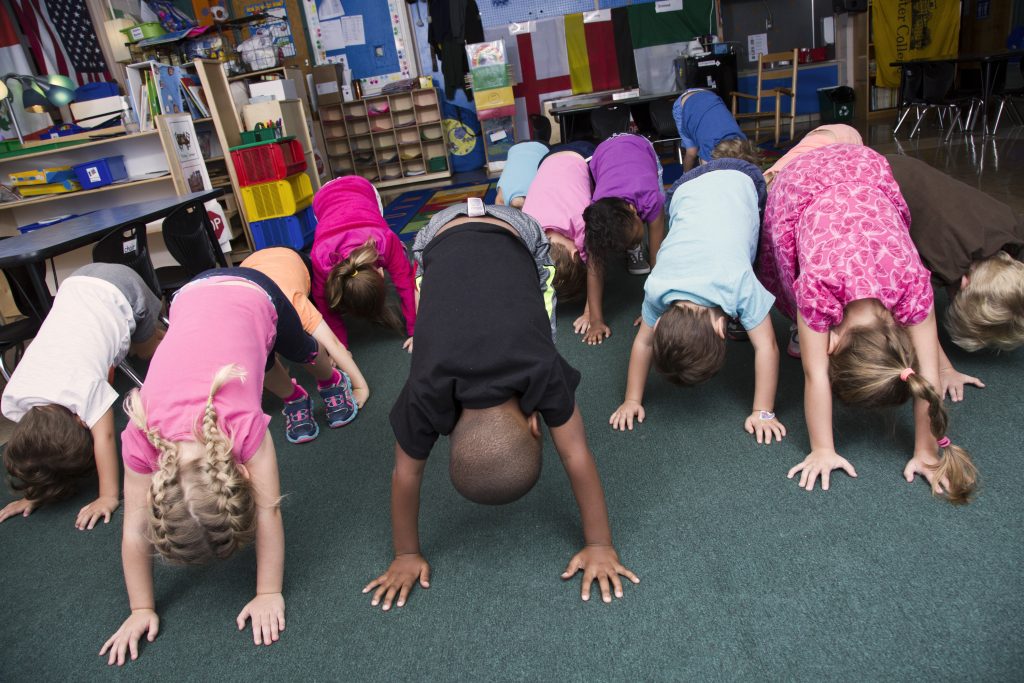
AISD Teacher of the Year James Butler practicing mindful breathing with his students (Credit: Stephanie Friedman)
The mindfulness movement has made its way into our daily lives, yet some still don’t completely understand what mindfulness really is, or how it can benefit them and their communities.
Mindfulness is the purposeful attention on the present moment—the awareness of your thoughts and actions—and accepting these thoughts without judgement. Studies have proven that mindfulness, in both adults and children, improves both mental and physical health. So why aren’t we all practicing mindfulness everyday? Perhaps it’s the lack of understanding and/or training.
James Butler, Austin Independent School District Teacher of the Year and Pre-K teacher at Gullett Elementary School, is determined to change this. He’s bringing mindfulness into Austin classrooms with his Mindful Classrooms Curriculum. I spoke with Butler about his program and the importance of bringing mindfulness to Austin.
AISD Teacher of the Year

Mr. Butler demonstrating for a student (Credit: Stephanie Friedman)
When you first meet Butler, there’s no question why he was named Teacher of the Year. He has 14 years teaching experience, including teaching abroad for a year in rural Namibia. Early childhood education is his passion, and five years ago he helped establish the Pre-K program at Gullett Elementary.
The first thing I noticed about Butler was his infectious laugh. The second were the tattoos on his arms…of children’s artwork. No, he doesn’t have small children at home. They’re drawings from his students. And if that doesn’t say dedication to early childhood education, then I don’t know what does.
When I asked Butler how he got started with the idea behind Mindful Classrooms, he laughed and said, “First off, I’m not a yogi. But I do believe in living in the moment. It became very apparent to me while teaching in Namibia.” Overseas, he used mindfulness as a way to relieve stress and bond with his students. Back in Austin, he started incorporating mindfulness into his daily teaching routine.
In the summer of 2015, AISD Superintendent Paul Cruz learned of Butler’s Mindful Classrooms curriculum and immediately helped to get it into more classrooms in the school district. Today, Mindful Classrooms is in 45 Austin area elementary schools. That’s 250 classrooms and counting.
Alexander and the Terrible, Horrible, No Good, Very Bad Day

Pre-K students in frog pose (Credit: Stephanie Friedman)
The children’s book by Judith Viorst, “Alexander and the Terrible, Horrible, No Good, Very Bad Day,” is one of Butler’s favorites to read with his students. “Everyone has bad days and makes mistakes. But can you learn from those mistakes?” That’s where the Mindful Classrooms curriculum really makes a difference. With five minutes of daily stretching and breathing practices, children are able to learn to be aware of what’s happening in the present moment, and thus are able to be more self-reliant and self-aware in potentially stressful moments.
So is Mindful Classrooms working? Yes!
In addition to national studies which confirm the mental and physical benefits of mindfulness, early AISD surveys show a 75% average improvement in the following categories: class atmosphere, students handling emotions, conflict resolution and teacher self-reflection. If that’s not enough, then just ask the students. One of Butler’s former students, now in third grade, shared: “Mindfulness helps me find peace and quiet.”
Not Just for Students
Mindful Classrooms not only empowers students, but it also empowers teachers. “The more aware and in-tune teachers are with the students,” Butler explained, “the more they can focus on the why something is happening, rather than the issue alone.” Mindfulness is not about solving all the classroom problems in one fell swoop. It’s about learning to be present together.
Each teacher is encouraged to work with students to determine what’s most beneficial to the classroom.
“In the hurried pace of our world, it is important to me that I am mindful of the quality of attention brought to each and every task. We are surrounded by multi-tasking, but many times if my attention is on multiple tasks, I am not completely present for each task. Taking a moment to be silent and still helps me to be more efficient, and clearly be more available to do the tasks at hand. Just a few mindful moments allows an increase in my attention and to reap the benefits of being completely present to the moment-by-moment experiences of life. It is the small moments in life that bring rich rewards and I am excited that the children in our schools will have opportunities each day to be mindful of the wonder around them.” -Jacquie Porter, Director of Early Childhood, Austin Independent School District
The Future of Mindful Classrooms

Future leaders of Austin (Credit: Stephanie Friedman)
Mindful Classrooms teaches kids to be present and cope with daily stresses. It’s a simple concept, but out of reach for so many. Butler’s personal goal is to get as many teachers and students participating in the program as possible. He believes in the power of self-awareness, self-sufficiency and self-empowerment at any age.
How can you help bring Mindful Classrooms to your community? If you have children, you can start by asking whether your school is participating in the program, and encourage them to start. You can also help by supporting the Mindful Classrooms Kickstarter which will help expand curriculum to include mindful listening, seeing and eating, create a 36-week ebook for teachers, produce additional classroom resources, and help to train teachers.
@jpino9 wants to know:
Do you practice mindfulness in your daily life?
- Hiking in Austin – 9 Best Hike Trails & Hiking Spots - August 13, 2021
- Guide to Austin’s East Sixth Street - February 25, 2020
- Austin’s Best Bazaars, Fairs, and Markets for Your Holiday Shopping - November 26, 2019


This is religion – why is this allowed in school??